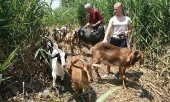I suspect that there would be so much more milkweed around for the monarchs if people would just recognize what great vegetables it makes.....it's a
perennial edible with stacking functions, 3 of which are great vegetables...spring shoots, flower buds and young pods! After reading Sam Thayer's
books and learning that I didn't have to do 3x boiling with common milkweed I decided I'd like to add it to one of the sunny zones in my forest garden....and then it showed up by itself!!! Nothing like a
native perennial edible whose seeds blow in on the wind. So I left it alone and now there's a nice clump there.
I highly recommend Sam Thayer's books. For a bit more on cooking with milkweed check out
this site. If we all started growing and enjoying milkweed in our edible landscapes the monarchs wouldn't know what to do with all the clumps along their flight paths :)











